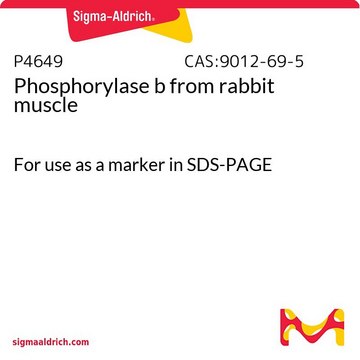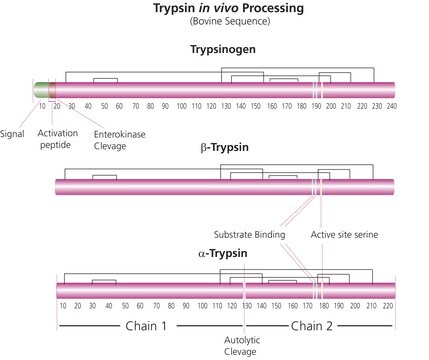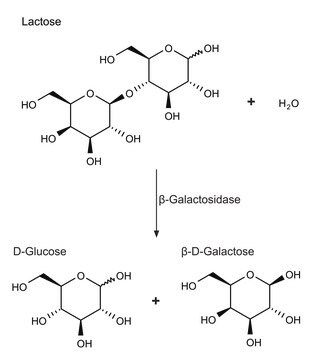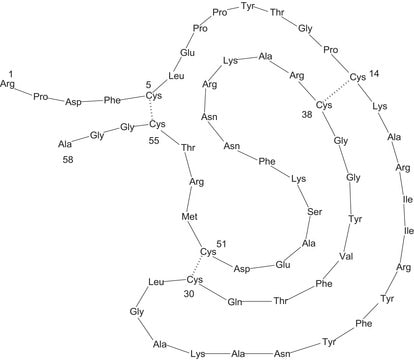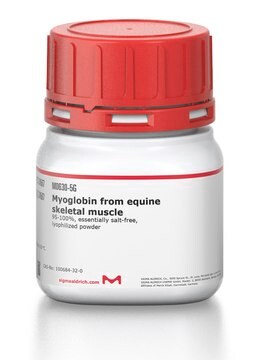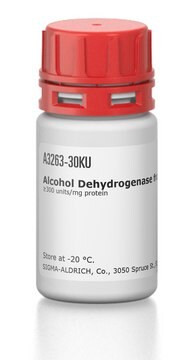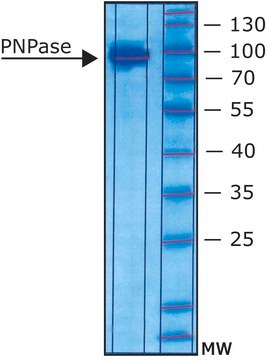P6635
Phosphorylase b from rabbit muscle
lyophilized powder, ≥20 units/mg protein, 2× crystallization
Synonym(s):
α-Glucan Phosphorylase, 1,4-α-D-Glucan:orthophosphate α-D-glucosyltransferase, Glycogen Phosphorylase
About This Item
Recommended Products
biological source
rabbit muscle
Quality Level
form
lyophilized powder
specific activity
≥20 units/mg protein
mol wt
97,200 Da by calculation
purified by
2× crystallization
storage condition
(Keep container tightly closed in a dry and well-ventilated place)
technique(s)
mass spectrometry (MS): suitable
impurities
~0.01 μmol/mg protein 5′-AMP (This low level will not interfere with phosphorylase and phosphorylase kinase assays.)
UniProt accession no.
foreign activity
phosphoglucomutase ≤1.0%
phosphorylase a ≤10%
phosphorylase kinase ≤0.5%
phosphorylase phosphatase, debrancher enzyme, AMPase and ATPase ≤0.1%
storage temp.
−20°C
Looking for similar products? Visit Product Comparison Guide
General description
Glycogen phosphorylase (PG), a specialized complex allosteric enzyme has an evolutionarily conserved gene sequence. GP contains a family of three isozymes such as muscle GP (mGP), liver GP (lGP), and brain GP (bGP) in humans.
Application
- in the calibration of Sepharose C1-6B columns while studying the molecular weight of methylamine dehydrogenase subunits
- in ion mobility-mass spectrometry studies of phosphorylase B ions that have been generated with supercharging reagents, in the charge-reducing buffer
- for the preparation of p32 labeled phosphorylase A using phosphorylase kinase and [32P]ATP
- in phosphorylase phosphatase assay
- in enzyme assay as a positive control to ensure the reaction system for the activity determination was adopted
Biochem/physiol Actions
Packaging
Unit Definition
Physical form
antibody
Storage Class Code
11 - Combustible Solids
WGK
WGK 3
Flash Point(F)
Not applicable
Flash Point(C)
Not applicable
Personal Protective Equipment
Choose from one of the most recent versions:
Already Own This Product?
Find documentation for the products that you have recently purchased in the Document Library.
Customers Also Viewed
Articles
Glucose metabolism is regulated by the opposing actions of insulin and glucagon. Insulin is released from pancreatic ß cells in response to high blood glucose levels and regulates glucose metabolism through its actions on muscle, liver, and adipose tissue.
Our team of scientists has experience in all areas of research including Life Science, Material Science, Chemical Synthesis, Chromatography, Analytical and many others.
Contact Technical Service
